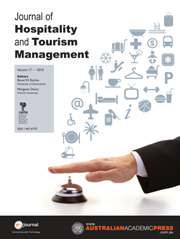Crossref Citations
This article has been cited by the following publications. This list is generated based on data provided by
Crossref.
Kelly, Catherine
2012.
Wellness Tourism: Retreat Visitor Motivations and Experiences.
Tourism Recreation Research,
Vol. 37,
Issue. 3,
p.
205.
Voigt, Cornelia
and
Laing, Jennifer H.
2013.
Medical Tourism and Transnational Health Care.
p.
30.
Bone, Kate
2013.
Spiritual Retreat Tourism in New Zealand.
Tourism Recreation Research,
Vol. 38,
Issue. 3,
p.
295.
Huang, Liyuan
and
Xu, Honggang
2014.
A Cultural Perspective of Health and Wellness Tourism in China.
Journal of China Tourism Research,
Vol. 10,
Issue. 4,
p.
493.
Yeoman, Ian
Mcmahon-Beattie, Una
and
Findlay, Katherine
2014.
The Future of Urban Spas: A Trend Analysis of the UK Market.
Tourism Recreation Research,
Vol. 39,
Issue. 3,
p.
397.
Fu, Xiaoxiao
Tanyatanaboon, Maneenuch
and
Lehto, Xinran Y.
2015.
Conceptualizing transformative guest experience at retreat centers.
International Journal of Hospitality Management,
Vol. 49,
Issue. ,
p.
83.
Bone, Kate
2015.
Selling Spirituality: Issues in Tourism.
Tourism Review International,
Vol. 19,
Issue. 3,
p.
123.
Chen, Chun-Chu
and
Petrick, James F.
2016.
The Roles of Perceived Travel Benefits, Importance, and Constraints in Predicting Travel Behavior.
Journal of Travel Research,
Vol. 55,
Issue. 4,
p.
509.
Hudson, Simon
Thal, Karen
Cárdenas, David
and
Meng, Fang
2017.
Wellness tourism: stress alleviation or indulging healthful habits?.
International Journal of Culture, Tourism and Hospitality Research,
Vol. 11,
Issue. 1,
p.
35.
Silvestri, Cecilia
Aquilani, Barbara
and
Ruggieri, Alessandro
2017.
Service quality and customer satisfaction in thermal tourism.
The TQM Journal,
Vol. 29,
Issue. 1,
p.
55.
Kay Smith, Melanie
and
Diekmann, Anya
2017.
Tourism and wellbeing.
Annals of Tourism Research,
Vol. 66,
Issue. ,
p.
1.
Page, Stephen J.
Hartwell, Heather
Johns, Nick
Fyall, Alan
Ladkin, Adele
and
Hemingway, Ann
2017.
Case study: Wellness, tourism and small business development in a UK coastal resort: Public engagement in practice.
Tourism Management,
Vol. 60,
Issue. ,
p.
466.
Tang, Chor Foon
and
Nathan Abdullah, Ahmad Sofwan
2018.
Can inbound medical tourism boost Malaysia’s economic growth?.
Tourism and Hospitality Research,
Vol. 18,
Issue. 4,
p.
505.
Luo, Yi
Lanlung (Luke), Chiang
Kim, Eojina
Tang, Liang Rebecca
and
Song, Sung Mi
2018.
Towards quality of life: the effects of the wellness tourism experience.
Journal of Travel & Tourism Marketing,
Vol. 35,
Issue. 4,
p.
410.
Hartwell, Heather
Fyall, Alan
Willis, Cheryl
Page, Stephen
Ladkin, Adele
and
Hemingway, Ann
2018.
Progress in tourism and destination wellbeing research.
Current Issues in Tourism,
Vol. 21,
Issue. 16,
p.
1830.
Kelly, Catherine
2018.
‘I Need the Sea and the Sea Needs Me’: Symbiotic coastal policy narratives for human wellbeing and sustainability in the UK.
Marine Policy,
Vol. 97,
Issue. ,
p.
223.
Ashton, Ann Suwaree
2018.
Spiritual retreat tourism development in the Asia Pacific region: investigating the impact of tourist satisfaction and intention to revisit: a Chiang Mai, Thailand case study.
Asia Pacific Journal of Tourism Research,
Vol. 23,
Issue. 11,
p.
1098.
Gill, Chelsea
Packer, Jan
and
Ballantyne, Roy
2019.
Spiritual retreats as a restorative destination: Design factors facilitating restorative outcomes.
Annals of Tourism Research,
Vol. 79,
Issue. ,
p.
102761.
Thal, Karen Irene
and
Hudson, Simon
2019.
A Conceptual Model of Wellness Destination Characteristics That Contribute to Psychological Well-Being.
Journal of Hospitality & Tourism Research,
Vol. 43,
Issue. 1,
p.
41.
Chamekh, Mohamed
2019.
The Interplay of Health, Pleasure and Wellness in British Seaside Resorts: the Case of Skegness on the Lincolnshire Coast.
Revue française de civilisation britannique,
Vol. XXIV,
Issue. 3,




